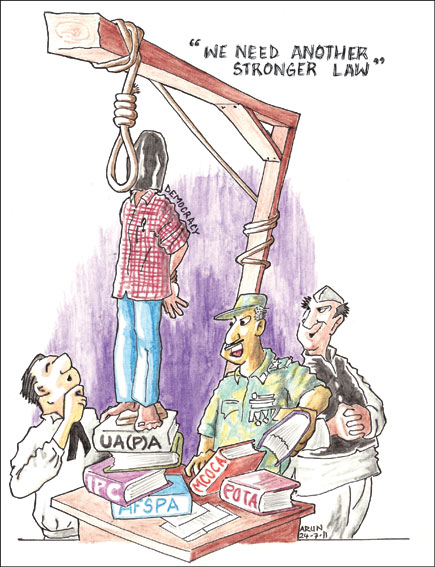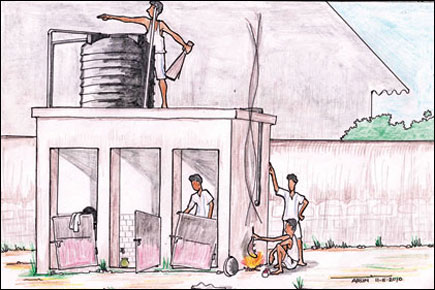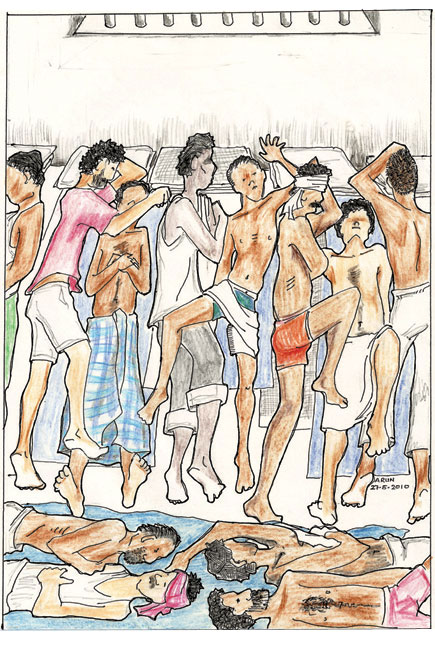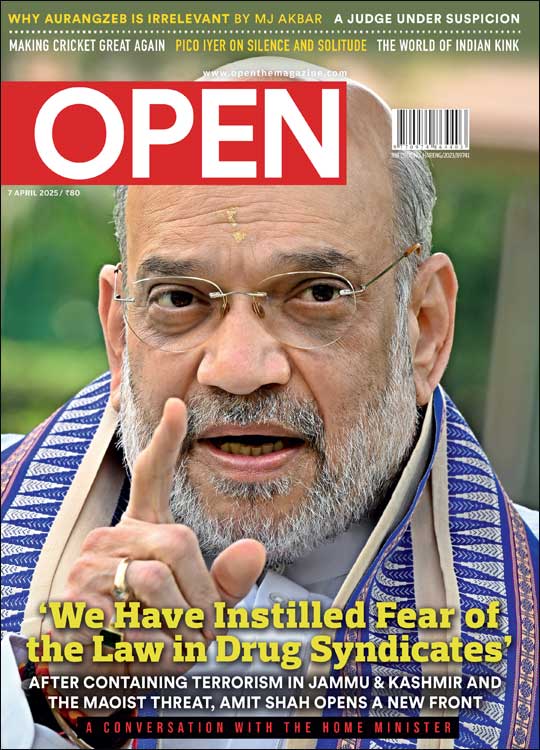Prison Diaries
Mumbai-based activist Arun Ferreira kept a prison diary during his incarceration in Nagpur Central Jail. We reproduce here a shortened version of his experiences and some of the sketches he drew in prison
 Arun Ferreira
Arun Ferreira
 Arun Ferreira
|
14 Jun, 2012
Arun Ferreira
|
14 Jun, 2012
/wp-content/uploads/2015/11/diaries-cartoon2.jpg)
Mumbai-based activist Arun Ferreira kept a prison diary during his incarceration in Nagpur Central Jail. We reproduce here a shortened version of his experiences.
After spending about five years in jail, Mumbai-based activist Arun Ferreira was released on bail in January this year. In May 2007, he was arrested in Nagpur on charges of being a Naxalite. The police claimed that he along with a senior Naxal leader, Ashok Satya Reddy alias Murali, was planning to blow up the historical Deekshabhoomi complex (where Babasaheb Ambedkar embraced Buddhism in 1956). In September 2010, he was acquitted of all charges by a Nagpur court, but was re-arrested by plainclothes policemen and charged with an alleged crime that occurred when Ferreira was locked up in jail. An alumnus of Mumbai’s St Xavier’s College, 39-year-old Ferreira kept a prison diary during his incarceration in Nagpur Central Jail. We reproduce here a shortened version of his experiences and some of the sketches he drew in prison.
The anda barracks are a cluster of windowless cells within the high-security confines of Nagpur Central Jail. To get to most cells from the anda entrance, you have to pass through five heavy iron gates, [and] a maze of narrow corridors and pathways. There are several distinct compounds within the anda, each with a few cells, each cell carefully isolated from the other. There’s little light in the cells and you can’t see any trees. You can’t even see the sky. From the top of the central watch tower, the yard resembles an enormous, airtight concrete egg. But there’s a vital difference. It’s impossible to break it open. Rather, it’s designed to make inmates crack.
The anda is where the most unruly prisoners are confined, as punishment for violating disciplinary rules. The other parts of Nagpur jail aren’t quite so severe. Most prisoners are housed in barracks, with fans and a TV. In the barracks, the day-time hours can be quite relaxed, even comfortable. But in the anda, the only ventilation is provided by the gate of your cell, and even that doesn’t afford much comfort because it opens into a covered corridor, not an open yard.
But more than the brutal, claustrophobic aesthetic of the anda, it’s the absence of human contact that chokes you. If you’re in the anda, you spend 15 hours or more alone in your cell. The only people you see are the guards and occasionally the other inmates in your section. A few weeks in the anda can cause a breakdown. The horrors of the anda are well-known to prisoners in Nagpur jail, and they would rather face the severest of beatings than be banished to the anda.
While most prisoners spend only a few weeks in the anda or in its cousin, the phasi yard, home to prisoners sentenced to death, these sections were where I spent four years, eight months. This was because I was not an ordinary prisoner. I was, as the police claimed, a ‘dreaded Naxalite’, ‘Maoist leader’, descriptions that appeared in newspapers the morning after I was arrested on 8 May 2007.
I’d been arrested at Nagpur railway station on a brutally hot summer afternoon. I was waiting to meet some social activists when about 15 men grabbed me, bundled me into a car and drove away at high speed, kicking and punching me all the while. They took me to a room in a building my abductors later told me was the Nagpur Police Gymkhana. They used my belt to tie my hands and I was blindfolded, so that the police officials involved in this operation could remain unidentified. From their conversations, it became evident that I had been detained by the anti-Naxalite cell of the Nagpur Police. The assaults never stopped. Through the day, I was flogged with belts, kicked and slapped, as they attempted to soften me up for the interrogations that were to follow.

I had my first brush with social activism as a student at Mumbai’s St Xavier’s College in the early 1990s. I’d organised camps to villages and welfare projects for the underprivileged. The religious riots of 1992-93 really shook me up. Thousands of Muslims were displaced in their own city, and we helped run relief camps. The callousness of the state, which allowed the Shiv Sena to conduct its pogrom unimpeded, could not have been on better display. I soon joined the Vidyarthi Pragati Sanghatan, a student organisation that aimed to build a democratic, egalitarian society. We organised many campaigns in rural areas to help the dispossessed assert their rights. In Nashik, tribals were organising themselves against atrocities of the Forest Department. In Dabhol, villagers were resisting the Enron power project. In Umergaon, Gujarat, fisherfolk were protesting their imminent displacement by a gigantic port. Looking at these struggles up close made me aware that [offering] relief to the poor wasn’t as important as helping them question the skewed relations of power and justice and organise themselves to claim their rights.
However, post 9/11, there was a change in the way peoples’ movements came to be perceived. The so-called War Against Terror made security the prime motive of State policy. In India, special laws were promulgated to squash inconvenient truths. Organisations were banned, opinions were criminalised and social movements were branded ‘terrorist’. Those of us who worked to organise tribals or the oppressed in rural areas were termed ‘Maoists’.
In 2010, Prime Minister Manmohan Singh declared that Maoists were “India’s greatest internal security threat”. Some were ‘encountered’ or ‘disappeared’, while others were arrested. In places like Chhattisgarh, Jharkhand or Vidarbha in Maharashtra, all non-partisan political activity was branded as ‘Maoism’ and dealt with accordingly. In the months before my detention, many Dalit activists in Nagpur had been arrested on charges of radicalising the Amberkarite movement by infusing it with the politics of Naxalism. All this meant that I wasn’t entirely unprepared to be arrested myself.
Despite having contemplated this hypothetical situation, I wasn’t quite prepared to become a target of [State] excesses myself—to be arrested, tortured, implicated in false cases with fabricated evidence, and locked away in prison for several years.
At midnight, 11 hours after I had been detained, I was taken to a police station and informed that I had been arrested under the Unlawful Activities Prevention Act, 2004, which is applied to people the State believes are terrorists. I spent that night in a damp, dark cell in the police station. My bedding was a foul-smelling black blanket, its colour barely concealing just how dirty it was. A hole in the ground served as a urinal and could be identified by paan stains around it, and its acrid stench. I was finally served a meal: dal, roti and a couple of abuses. Having to eat from a plastic bag with jaws sore from [the day’s] blows wasn’t easy. But after the horrors of the day, these tribulations were relatively insignificant and allowed me a brief moment to pull myself together. I managed to ignore the putrid bedding and humid air and doze off.
Within a few hours, I was woken up for another round of interrogation. The officers appeared polite at first but quickly resorted to blows in an attempt to make me provide the answers they were looking for. They wanted me to disclose the location of a cache of arms and explosives or information on my supposed links with Maoists. To make me more amenable to their demands, they stretched my body out completely, using an updated version of the medieval torture technique of [the wrack]. My arms were tied to a window grill high above, while two policemen stood on my stretched thighs to keep me pinned to the floor. This was calculated to cause maximum pain without leaving any external injuries. Despite their precautions, my ears started to bleed and my jaws began to swell up.
In the evening, I was made to squat on the floor with a black hood over my head as numerous officers posed behind me for press photographs. The next day, I would later learn, these images made the front pages of papers around the country. The press was told that I was the chief of communications and propaganda of an ultra-left wing of Naxalites.
I was then produced before a magistrate. As all law students know, this step has been introduced [to the legal process] to give detainees an opportunity to complain against custodial torture—something I could establish quite easily since my face was swollen, ears bleeding and soles so sore it was impossible to walk. But in court, I learnt from my lawyers that the police had already accounted for those injuries in their concocted arrest story. According to their version, I was a dangerous terrorist and had fought hard with police to try to avoid arrest. They claimed that they had no option but to use force to subdue me. Strangely, none of my captors claimed to have been harmed during the scuffle.

That wasn’t the only surprise. In court, the police said that I’d been arrested in the company of three others—Dhanendra Bhurule, a local journalist; Naresh Bansod, the Gondia district president of an organisation called the Maharashtra Andhashraddha Nirmulan Samiti; and Ashok Reddy, a resident of Andhra Pradesh, people I had never met before. The police claimed to have seized a pistol and live cartridges from us. They said we had been meeting to hatch a plan to blow up the monument at Deekshabhoomi in Nagpur. If the police could convince people that Naxalites were planning to attack this hallowed shrine, this could convince Dalits not to [have any] truck with leftists.
But mere allegations couldn’t suffice. They needed to create evidence to support their claims. The police told the court that they needed us in custody for 12 days to interrogate us. While the journalist and I were kept at Nagpur’s Sitabuldi police station, the other two were taken to the Dhantoli police station. Every morning, we would be transported to the Police Gymkhana for continuous rounds of interrogation that lasted late into the night. First, they attempted to force us to sign a confessional statement they had drafted. When that failed, they got the court to agree to allow us to be subjected to the scientifically dubious practice of narco-analysis, lie detectors and brain mapping tests, which they hoped would bolster their allegations. So although legally I was no longer in their custody, the police could still interrogate me under the guise of conducting these forensic tests. Preparations were made to transport us to the State Forensic Science Lab in Mumbai.
Before that, we were formally admitted to Nagpur Central Prison. I stooped through the low narrow door into the complex that would be my home for 54 months. In keeping with procedure, first-time prisoners are presented before the gate-officer. Tradition, and perhaps training, demands that even the most mild-mannered gate-officer be at his aggressive best while dealing with new entrants, who, in jail slang, are called ‘Naya Ahmads’. It is the gate officers’ job to give the newcomer a crash course in meekness and mindless subservience. A lathi at his side serves as a teaching aid.
The officer is also supposed to enquire whether the new prisoner has suffered injuries due to torture in police custody, and, if so, record his statement. In my case, I had a bleeding ear, swollen jaws and sore feet. But in reality, the officer threatens anyone trying to make a complaint. By custom, all injuries are recorded as having existed before the prisoner was arrested. A strip search followed, standard protocol for new entrants to the prison. I was stripped to my underwear and ordered to squat in a line with the other new entrants awaiting my turn with the jadthi-amaldar (the man in charge of searches). Our every belonging was scrutinised and thrown on the dirty road for us to humbly gather together again. Hazards like packets of biscuits and beedis were pocketed by the staff.
We were unfortunate to arrive in isolation, but if the prisoner’s wait at the gate coincides with the entry or exit of one of the senior jail officials, he is privileged to witness a ceremony of colonial vintage. Senior jailors and superintendents can’t be expected to bend low to enter through the door. So the main gate is swung open to allow these sahibs to walk through, heads held high. When they are sighted at a distance, the gate guard issues a yelp of caution: “All hup!” All staff stand to attention and all lower life forms are swept into corners out of sight or forced to their haunches.
Most Naya Ahmads are then taken to the After Barrack, where they spend a night or two before being assigned to a fixed barrack. This waiting period allows the jail staff, convict-warders, inhouse extortionist gangs and other sharks to assess what they can extract from the latest catch. Middle and upper class entrants are easy targets. They are softened up with dark stories of prison-life horrors and not-so-veiled threats. Young boys are targeted for free labour and as sex toys. Contacts are made and deals are struck to ensure better treatment when moved to the regular barracks.
Next is the mulaija or check-in-process. New prisoners are lectured on the value of prison discipline by a convict warder or jailor. Each new inmate has his identifying marks noted and is weighed, measured and examined by a doctor and psychologist, before being presented before a phalanx of prison divinities, led by the Superintendent. A Body Ticket is presented to each prisoner, listing his prisoner number and offences registered against him. These offences form the basis of how he will be classified, and, to some extent, how he’ll be treated in jail.

Even though the law proclaims that an accused person is innocent until proved guilty, such niceties lack meaning behind prison walls. The allegations of the police are sufficient evidence for the jail authorities to punish even those awaiting trial. Alleged rapists and homosexuals are routinely targeted by officers and other prisoners at the encouragement of the staff. Those implicated in murder cases are compelled to wear a convict prisoner’s uniform and are consigned to special ‘murder barracks’. As a sign of their patriotism, many jail superintendents personally preside over the beatings of people accused of terrorism.
Before the mulaija, procedure requires the new entrant to be bathed. However, shortages of soap and water often prevent the diligent observance of these rules. Instead, most Naya Ahmads are rushed through the rough-and-ready hands of the nai kamaan (literally, the Barber Command), one of the work groups to which prisoners could be assigned later. The Naya Ahmad’s next stop is the Badi Gol, the area in Nagpur Jail that houses the prisoners awaiting trial. Each is allotted a barrack. That, theoretically, is where I should have been headed too. But in my case, the procedures were all jumbled up. Twelve days after I had been picked up by the police, I was hurriedly put into the anda barrack, given a prison uniform, and after a quick meal at 4 pm of besan and chewy rotis, [put on my way] to Mumbai by train.
Even before [detainees] can be given narco-analysis, they are put through a series of medical tests, ostensibly to ascertain whether they are fit enough to undergo these forensic procedures. In reality, the tests determine the prisoner’s levels of resistance and help the authorities calculate how much of the drug, sodium pentothal, can be administered without causing the accused to collapse. The tests were conducted in the operation theatre of JJ Hospital, a government hospital in Mumbai that has backup facilities for surgery. That’s because sodium pentothal can cause the heart to slow down—fatally.
The drug was administered like a drip, at a controlled pace so that I should remain in a trance for [a long] time. The forensic psychologist started asking questions and the conversation was video recorded. Although the police were not permitted to enter the laboratory, the forensic experts themselves used the drug with police efficiency, with total disregard for medical ethics or my health. The police had prepared a list of questions for the psychologist to ask: where I kept arms and ammunition, and whether I was associated with suspected organisations or people. I remembered some of this later. It was a little like recollecting a dream after waking up. I didn’t remember all the details with complete accuracy, but I hadn’t forgotten the highlights.
On my return, after a week, I was implicated in another five cases involving Naxalite violence. The police were granted another 20 days of custody. This meant that I was back in the hands of the police at a police station in Gondia district. This entailed more sleep deprivation, more harassment and more interrogation. I was fortunate to have got away relatively lightly. The police injected petrol into the rectums of two of my co-accused, which resulted in days of anal bleeding. For me, it was more stretching, flogging with a strip of conveyor belt, which the Maharashtra police affectionately call “Bajirao”, and more jaw slamming.
By this time, the results of the Mumbai narco-analysis tests had come in. They failed to provide any grist for the police case, so the authorities got a court to surreptitiously order another round of tests at the forensic lab in Bangalore. Here, the tests were conducted by the notorious S Malini, who was later dismissed from duty when it was discovered that she’d submitted false papers when applying for the job. Malini was well regarded by police forces across India because she always managed to get them the results they wanted. She had apparently solved the Malegaon blasts case of 2006, the Mecca Masjid blasts case, and also the Sister Abhaya case. Years later, all these were proved to have been falsely investigated. During narco-analysis, she slapped and abused me, pinched my ears with pliers, and even administered electric shocks to me and my co-accused to keep us from turning unconscious.
But this didn’t do the job either. So the police implicated me in two more cases and interrogated me for two more weeks. That’s how the first year of life after my arrest proceeded. The police would implicate me in new cases, obtain custody to interrogate me, inflict terrible forms of torture on me, fail to extract a confession, return me to jail, only to implicate me in yet another case. It was only when the police finally filed chargesheets in these cases that I had a new routine, one that involved making weekly or sometimes daily trips to court to wait for these cases to be heard. I now had the luxury of contemplating the rhythms of prison life.
Morning brings a mad rush to the tanki or haus, as the bathing tank is known. Four hundred prospective bathers laying claim to a 60 by 3 foot trough means a hurried bath even at the best of times. In summer, when the water being pumped out of the well is likely to run dry, the pace is bound to be frantic. Jail lore tells of the guy who’s not fast enough and has to rinse off the soap by catching the drops dripping off his neighbour’s body. The ones who don’t learn to brush teeth, take a bath and rinse out their underwear in 10 minutes flat are destined to scrape the bottom of the haus.
Negotiating the morning crowds at the tanki and long lines at the toilets requires not only speed but some presence of mind. This is particularly important in the yards and barracks with a large number of undertrials who have to prepare to attend court. In less than two hours, between the opening of barracks at 6.45 am and the court call at 8.30 am, they have to not only complete ablutions and a bath, but also catch their queues to collect and then have tea at 7 am, breakfast at 7.30 am and lunch between 8 am and 8.30 am.
It wasn’t easy for my body to adjust to the absurdity of having lunch just a half hour after breakfast. The early lunches, like so much else in prison, are the result of sheer callousness. Undertrials often spend the hours between 8.30 am and 6.30 pm on their way to court, in court, and being driven back, but the jail authorities have not seen it fit to provide them a packed lunch that can be had in the afternoon. High Court orders directing that this should be done are observed in the breach. But since the Jail Manual, which governs all activities in prison, has laid down just what a prisoner must consume, the authorities fulfil their obligations by distributing lunch to undertrials at 8 am. But when you are one among many hundreds running after scarce resources, you normally end up giving up something—either your toilet or bath, breakfast or lunch.
The food distribution is done by the energetic taapa kamaan, one of the many prisoner teams that play a vital role in keeping the jail functioning. The taapa kamaan are busy from the time the barracks are opened at around 6.45 am until they are locked around 5 pm, running around with large food containers—the taapaas from which they take their name. Two thousand stomachs demanding their timely due can be a tense proposition, and the taapa workers are a harried lot. They have to ensure that each Manual-prescribed item reaches each barrack in sufficient quantities to supply the stipulated amount to every prisoner present at the morning count.
Within this unit, the post of taapa commander can be quite a lucrative assignment. The commander is normally a convict warder, a long-serving prisoner who is given the duty of an overseer of other labouring prisoners. He is paid Rs 35 per day, but can earn a healthy side income by trading the resources under his command. By manipulating distribution, he can generate a surplus to be placed on the open market. The bhais who pay him off get more and better food. But the taapa commander’s privileges pale in comparison with the deals that jail officials strike with contractors who supply the kitchen raw materials. Many jail employees are able to take enough home to feed their families on prison supplies. These leaks result in the depletion of food that prisoners are served. In order to ensure that portions meet the weight stipulations of the Jail Manual, even the most inedible portions of vegetables make their way into prisoners’ thaalis—this can even include the rope that suppliers use to tie vegetables together.
As a result, we often attempted to improvise. One way out was to re-cook the food by spicing it up with pickles and chilli-garlic powder purchased from the prison canteen. This process is called handi, after the cooking pots fashioned out of aluminium plates. We would fabricate a fireplace from bricks or by chiselling and reshaping other aluminium vessels. Strips of newspaper and sun-dried chapaatis were used for fuel, but sometimes bits of plastic, dry twigs, old clothes, pilfered prison bedding and even copies of legal documents found their way into the fire.
‘Handi’ is also the term for the group of prisoners who take their meals together. They pool the provisions they buy from the canteen and forage from elsewhere. In the barracks, all members of a handi group sleep in one place. For people like me in the cells, however, [joining] a handi group wasn’t possible—we were locked alone in our cells so couldn’t have dinner together. Still, we ensured that the food cooked in one cell was passed on to others. This was managed through a strategy called the gaadi. The dishes would be placed on a piece of cloth that was dragged along the ground by using a string thrown from one cell to the next, rather like a sleigh made of fabric.
The Maharashtra government’s near-total ban on non-vegetarian food also challenges the skill and ingenuity of the prisoner. Trapping and hunting of squirrels, birds, bandicoots and other types of small game is a serious occupation. Even locusts and other insects that occasionally swarm the prison were collected to be sun-dried roasted and relished. Cloth traps sometimes managed to snare a bird. Others were brought down with make-do catapults. Traps in drainpipes and other passages sometimes yielded bandicoots. But the more popular method for both squirrels and rats was hunting by hand-and-stick. If one was sighted, a cry would go up and hunters would gather to corner the prey.
A well-fed bandicoot—which tastes a lot like pork—was a sizeable feast for a meat-starved group. It was quickly depilated, dismembered and cooked in a corner away from the prying eyes of jail staff and their informants. The spot behind the latrines was considered safe. This was be done under the watch of the latrine-cleaning danda kamaan, who were omnivorous and enthusiastic participants in both the chase and feast. As the band sat around for the treat, the conversation would drift back to better times. A person would talk of wild boars, another would remember rabbits. The high walls and iron bars seemed to recede. Things weren’t as bad as they seemed.
Each barrack has its bhai to whom all lesser mortals claim or aspire to closeness. Those who succeed can hope for some alleviation in discomforts in the form of a cleaner or full set of bisthar (bedding). Though the Jail Manual says that the bisthar given should include a dhurry, a bed-sheet, two cotton-wool blankets in winter and pillow with pillow-case, the Naya Ahmad should consider himself lucky if he manages to get a single, tattered, filthy blanket or dhurry.
Even the deepest sleepers sometimes have to surrender to other sounds of the prison night. With each inmate living through his own private nightmare, moans, groans and sobs from adjoining sleepers are frequent. The awakened neighbour usually slaps the offender into silence. But not all troubled souls are so easily subdued. There are those who pierce the night with shrieks and are given much rougher strong arm [treatment] before they are quietened. The screamer who actually needs psychiatric help gets not even sympathy. As the whole barrack is roused, the more vicious types join the watchmen in beating and kicking him. Many believe this to be the only possible therapy to exorcise the devil who has taken possession of him. In a while, he is silenced and relative calm descends once more. But sleep is elusive, as [the quietened] prisoner strains silently to hide from his own demons. As seconds and minutes drag out, there is no clock to tell the time. Another hour is forfeited, never to be returned.
In this closed world, my only window to the outside was provided by books and magazines. However, Maharashtra prisons do not have any funds to buy printed material, not even official government publications. The prison library is completely dependent on donations from individuals or voluntary organisations. The selections are completely arbitrary, consisting mainly of religious books. At first, most of the magazines I tried to subscribe to by post never reached my cell. The jailor would decide what books were fit for us. We were once denied a James Bond novel because of its cover was deemed obscene. Every now and then, they’d block a magazine to us because it contained the word ‘Maoist’ or ‘revolution’. Even the Indian Constitution was withheld for being too bulky.
When we could get our hands on them, crime novels were always a hit. Lee Child and John Grisham novels would substitute for the absence of action or court room drama we longed for. I also read the Scandinavian novels of Stieg Larsson and Henning Mankell.
The other concession grudgingly allowed by the jail administration is the mulaakaat (meeting) with family and friends. This is permitted once a month to convicted prisoners and once a week to undertrials. The families who manage to save enough money to make the long journey from their village to the jail are expected to first register their names in the morning at the mulaakaat booth near the jail gate. They must hang around for three or four hours, braving sun or rain, as the jail administration supposedly checks whether they are security worthy of a mulaakaat and have not yet exhausted their quota. After an exhausting wait, the visitors—most often women and children—are then led in batches to a room with heavily meshed windows, each with a prisoner waiting on the other side. On the other side, the prisoners have been warned that they should not exceed the time sanctioned for their mulaakaat. Undertrials get 20 minutes; convicts, 30 minutes. There is always a certain desperation on both sides of the mesh, as prisoners and their families make sure that nothing to be conveyed is missed in the short time at hand.
My first visitors were my parents and brother. Although my wife wanted to visit me, we decided that she should not do so because of police threats to arrest her too. At the first mulaakaat, my parents could only see me as a silhouette behind the wire mesh. They had only by voice to recognise me by. The wire mesh ensured that no reassuring hugs could be exchanged. As my detention stretched on, my family only managed to meet me every two months. We’d plan to meet when I was being produced in court, though the guards escorting me would occasionally refuse to grant us this luxury. Through my years in jail, my baby son never got to see me. He did not know that I was in prison. If he had come, he’d have to see a silhouette with fettered hands for a father. We felt that this would be too much for a two-year-old to understand.
My family would try to fill me in about happenings at home, and I would entertain them with anecdotes about prison life. But as the number of cases in which I was being charged kept increasing, developments in each trial became more confusing, and discussing them with my aged parents became difficult. Ultimately, the mulaakaats narrowed to my giving them a list of things I required and their promising to bring them to the next meeting and write regularly.
As I realised in Nagpur Jail, the majority of inmates didn’t fit any recognisable definition of a ‘criminal’. They had landed in jail either because they had been falsely implicated by the police or because of an attack they’d committed in a fit of anger, often during a family feud. They had been convicted due to poor legal advice at their trials.
After the initial shock conviction, they had to steer stoically into a routine amenable to living out the long years in jail—which in the case of life sentences in Maharashtra average 17-18 years.
A large number find some solace in a rigid schedule of prayer and fasting, puja, namaaz and roza. Prison nurtures spirituality. It has the merit of at least temporarily inducing the type of peace obtained by casting your lot with the supernatural. The sanctimony of ritual has the sanctity of administrative approval. It benefits the prisoner to show up at, or even organise, religious ceremonies sanctioned by the jail management.
This game of hide-and-seek between illusion and fact, between hope and despair, is the constant of almost any prisoner’s existence. The trick to be mastered is to ensure that fact is not permitted to pierce illusion and despair not allowed to overcome hope. Once prisoners realise this, it isn’t really that difficult to keep their balance.
As an undertrial, you tell yourself that the trial’s going well, all witnesses [against you] have failed, and you are bound to be acquitted. If you have been convicted, you pin your hopes on the higher courts. And in this, the endemic delays of the Indian judicial system are a real blessing. Hope remains alive till the Supreme Court, by which time you have reached what you feel should be the end of your sentence. It is then the remissions and pardons that you look forward to.
You enter that puzzled yet hope-filled period of waiting for the finalisation of your likhaan, the colloquial term for the review file prepared by the Jail Judicial Department for every long-sentence convict. This document is sent to the state government for reviewing prisoners’ sentences and to obtain an order of premature release. This file reports the prisoner’s conduct in jail and contains calculations of the set-offs he is eligible for. It also contains recommendations of the jail, police and administrative authorities. Since government rules for a premature release are so complicated, it is rare for any prisoner to be able to estimate what likhaan he will finally get.
It takes years for Mantralaya to decide. It is only then that you have some idea of when you can expect to be finally released. This starts your ulti ginti, the countdown, as you tick off the days remaining for you to go home.
Throughout all this, as you battle to maintain your balance, the abiding symbol of hope and despair is the Lal Gate, the red exit gate. It reappears in rhetoric, in small talk, in jokes and of course in your dreams. It is the barrier that holds you in and the opening that will lead you out. The secret is to ignore the barricade and only see the door. That helps maintain some semblance of normal life.
But for some, the long years of prison life are without the slightest contact or communication with the outside world. Poverty prevents them from even finding the money for the surety the State demands for sending a prisoner on furlough or parole.
Besides, many families can’t afford the expense of travelling to jail for the monthly mulaakaat. Illiteracy or a breakdown of family relations could mean that there won’t even be a letter. As the lonely years stretch on, the line separating these prisoners from insanity steadily blurs.
Sixty-three-year-old Kithulal was one such person. He would cheat time to present some semblance of normal life. He would manage to convince himself that he’d almost done his time and that the benevolent government would soon announce a special remission that would see him released. The three or four months before each Republic and Independence Day were periods of carefully cultivated hope; anyone who cared to listen would be told that the Government will announce an extraordinary reprieve and he would walk out of the Lal Gate on the great day.
As the day would come and go, despair would render this most talkative of inmates unusually silent.
He’d then resort to other devices. He would get absorbed in a flurry of apparently irrational activity, as if sweat expended in sufficient quantities would wash away the pain. The normal opiate of fasts and other rituals would take on larger dimensions.
In a short time, he’d be pinning his hopes on his next release date.
In keeping with the law, I applied for bail in August 2007. However, I came to realise that speedy trials in the Indian judicial process are a luxury. It takes three-five years on average for a trial to be completed. For nearly a year-and-a-half, I would travel almost daily in a police van accompanied by armed police personnel for almost seven hours from Nagpur to Gondia or Chandrapur.
On reaching the court, I would find that I had been brought late or that the judge was on vacation. Often, my trips and those of my lawyers would go wasted because the prosecution witness had not turned up.
One particular case dragged on for over three years and was finally completed with my acquittal after the examination of only one witness. My captors were using the due process of law to penalise me. My only hope was to patiently complete each case and be finally released.
In my first year in prison, in the isolated anda barrack, my co-accused and I were kept away from the other prisoners because the jail administration considered us far too dangerous to be [allowed to associate] with them.
To signal that we were different, all alleged Naxalite prisoners were forced to wear prison uniforms with green arm bands. In April 2008, all 13 of us went on an indefinite hunger strike. Among our demands: end our isolation, stop arresting social activists as Naxalites, and don’t force undertrials to wear uniforms.
In order to undermine us, we were dispersed into separate barracks. I was transferred to phasi yard—for prisoners [on death row].
Our strike lasted 27 days. None of our demands were fulfilled. Instead, the police officer who was conducting an inquiry into the matter advised the jail officials to scatter us across other jails. An additional criminal case was registered against us, of attempting to commit suicide—this was the ninth case I had to deal with.
In September 2011, the courts finally dismissed the last of the nine cases against me. Prison wisdom says that the first few months of jail life and the last ones are the most horrible. As freedom neared, the days grew longer and nights sleepless. Court production dates also got reduced. All reading and writing became extremely burdensome. I started making plans for life beyond Lal Gate.
On 27 September, I left prison. I could see my parents standing outside. As they watched, in the company of journalists and my lawyers, a posse of policemen in plain clothes bundled me away in an unmarked vehicle. The police charged me with two more Naxalite-related cases, and I was sent back to prison.
I was crushed at the thought of having to [suffer] the same cycle of torture, bail applications and endless waits for trial dates all over again. But this time, thankfully, it was quicker. A vociferous public outcry and the skills of my lawyers worked in my favour.
On 4 January 2012, I was released on bail in the last remaining case. After four years, eight months, I walked out of Lal Gate a free man.
About The Author
CURRENT ISSUE
‘We Have Instilled Fear of the Law in Drug Syndicates,’ says Amit Shah
MOst Popular
4

/wp-content/uploads/2025/03/Cover_Amit-Shah.jpg)











More Columns
Why CSK Fans Are Angry With ‘Thala’ Dhoni Short Post
What’s Wrong With Brazil? Sudeep Paul
A Freebie With Limitations Madhavankutty Pillai